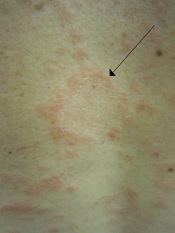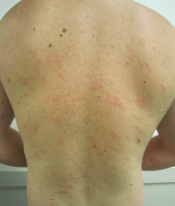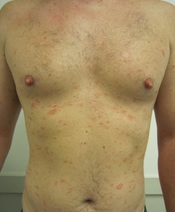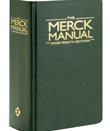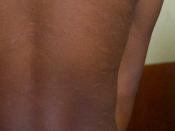An Overview of the ConditionÃÂPityriasis rosea is an inflammatory disease characterized by diffuse, scaling papules or plaques.ÃÂ-The Merck Manual of Diagnosis and Therapy. 18th edition.
Thought to have some correlation with the Human Herpes Virus 7, Pityriasis rosea (PR) is still considered to be idiopathic. Though PR was once assumed to be caused by bacterial infection, medicinal use, food or stress, studies have shown otherwise. PR is considered very common and non-contagious. Although the condition effects both sexes, it most commonly occurs in women, aged 8-40 in the spring or autumn. One correlation noted were occurrences happening in cooler months in temperate climates. PR is uncommon in people over 60 years of age, however, should the condition afflict people of that age group, their symptoms tend to last longer.
PR is known for pinkish to dark brown dry rash spots. These spots have central clearing and fine scales.
In 75% of cases, the outbreak of plaques is preceded by a ÃÂherald patchÃÂ on the thorax. This can either be a singular oval patch approximately 2-10 centimetres in diameter, or a cluster of smaller patches. Within two weeks of the ÃÂherald patchÃÂ appearing, a generalized eruption of smaller papules (0.5-2 centimetres in diameter) appears on the thorax, neck, arms, and/or thighs. Though PR is not usually found on the face, it can travel to the cheeks. These smaller papules tend to form along the lines of tension in the body. An example of this is the way the plaques found on the back are normally in the formation of a pine tree with sagging branches. PR tends to last anywhere from 6 to 12 weeks, spontaneously disappearing and only reoccurs in 3% of cases. However, in the months to follow an outbreak of PR, papules can return due to exercise or bathing in hot water.
PR is considered harmless and the only chief symptom, besides the papules, is pruritus, or itching. In 25% of cases, it is considered severe. In others, it does not happen at all. In some cases, feelings of a cold or upper respiratory infection can come before the ÃÂherald spotÃÂ. These cold symptoms can include: stuffy nose, sore throat, fever, headache, nausea, cough, congestion and fatigue. Upon disappearance of the papules, skin returns to normal and there are no permanent scars or damage to the skin. However, in darker-skinned people, pale or brown marks can stay on the skin for months afterwards.
The Economic Burden of Pityriasis RoseaThe economic burden of PR varies. One concern would be the effect it has on the female psyche. Girls and young ladies are prone to having issues about their appearance due to the bombardment on their senses from the media. Something like PR, which is mainly an aesthetic pathology, can cause an increase in the depression some of these girls feel. Many may choose to purchase expensive hypo-allergenic make-up or cover sticks to lessen the visibility of the rash or papules. Also, the cold symptoms can cause people to miss work and be unproductive; not knowing it is the beginning of PR. In this case, expensive medication would be a unproductive cost.
The Traditional Management of this Condition by the Medical CommunityBecause of the transient nature of PR, there is no medical treatment prescribed for the resolution of PR. Treatments prescribed are for the decrease of symptoms. These could be antihistamine pills, steroid or zinc oxide creams, calamine lotion, oatmeal baths and sometimes steroids to try to help clear rashes that persist longer then their usual time. Another technique used to try to decrease the rash is phototherapy (the use of UVB rays). They will also recommend avoidance of things that may exacerbate the condition, such as scented soaps and lotions.
Newer studies are attempting to see if acyclovir, famiciclovir, or erythromycin might speed recovery time be up to two weeks.
The Clinical Significance of this ConditionThere are many conditions that can have the same symptoms as PR. Such conditions are: eczema, psoriasis, ringworm, or syphilis infection. These make it possible to be misdiagnosis. As a massage therapist, we may be the first to see the condition due to the ÃÂherald spotÃÂ likely to be on the back. By being able to notice signs and symptoms, therapists can suggest a visit to a physician. Massage therapists can also know the disease is non-contagious and act accordingly.
How this Topic is Relevant to Massage TherapistsThis topic is relevant to massage therapists because it is a very common pathology. People visiting massage therapists may have this condition. Massage therapists should also know how to recognize a ÃÂherald spotÃÂ since they might be the first to see it. By knowing what different conditions it could be, massage therapists can better their patientsÃÂ lives by knowing what can help them decrease their symptoms and whether or not they should go to a physician immediately.
Being a common skin pathology, massage therapists will be able to see people who have PR. By understanding that it is a non-contagious disease that will go into remission within 3 months, massage therapists can treat the person with the care and treatment they need without concern. By knowing about this pathology, a massage therapist can also help educate their guest to understanding what is to come and what to expect.
References"Adolescent Health Curriculum - Medical Problems - Dermatology - Quiz (B4)." USC Keck School of Medicine. 27 Sept. 2007 .
"MedlinePlus Medical Encyclopedia: Pityriasis Rosea on the Chest." U.S. National Library of Medicine, National Institutes of Health. 27 Sept. 2007 .
"Pityriasis Rosea -- Familydoctor.Org." American Academy of Family Physicians. 27 Sept. 2007 "Pityriasis Rosea - MayoClinic.Com." Mayo Clinic. 27 Sept. 2007 .
"Pityriasis Rosea." 27 Sept. 2007 .
"Pityriasis Rosea." American Osteopathic College of Dermatology. 27 Sept. 2007 .
"Pityriasis Rosea. DermNet NZ." New Zealand Dermatological Society Incorporated. 27 Sept. 2007 .
"Pityriasis Rosea." The Merck Manual of Diagnosis and Therapy. 18th ed. Whitehouse Station: Merck Research Laboratories, 2006.
"Pityriasis Rosea." The New York Times Company. 27 Sept. 2007 .
"Pityriasis." Taber's Cyclopedic Medical Dictionary. 20th ed. 2005.
